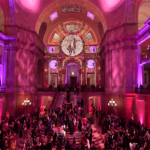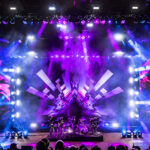Large Screen Video provides ultra-high-resolution video screens in the heart of San Francisco
Imagine that you’re in charge of the video screens and on-the-fly production for 50 acts in three days on eight stages—three outdoors and five indoors. Many acts arrive maybe half an hour before they go on and conduct shorthand explanations of what they want to happen behind them or alongside them as they perform. You and a crew of 30 work feverishly to keep things moving and pull off a flawless series of performances.
To veterans of big events and live performances, this sounds like the experience at any other major festival. Now let’s imagine one more thing: All of this is taking place in the heart of San Francisco, closing city streets late Thursday night, June 1, and making them traffic-ready again by 6 a.m. on Monday, June 5.
This is Colossal Clusterfest, a massive comedy event presented by cable network Comedy Central and produced by Superfly Productions and Another Planet Entertainment. The whole shebang took place at San Francisco’s Civic Center Plaza and the neighboring Bill Graham Civic Auditorium, with outdoor stages in the square bordered by the city’s government buildings and the Asian Art Museum.
The event featured headliners Jerry Seinfeld, Kevin Hart, Bill Burr, Sarah Silverman, Chris Hardwick and T.J. Miller, with music acts including Ice Cube, Chromeo, the Preservation Hall Jazz Band, Superjam featuring Les Claypool’s Bastard Jazz and others.
“We did all the screens, all the cameras and directing at the stages,” said John Rigney, managing partner of Large Screen Video (LSV), “and we were very much honored to be part of the project. We were serving at the pleasure of Another Planet, Joel Carmichael at Lambda Productions, the people who do Bonnaroo, and the team from Superfly. It was a tremendous logistical undertaking—not your typical festival setup.”
LSV production coordinator Ava Reich could attest to this, as she served as on-the-ground point person for the event. “There was rerouting of traffic, the problem of creating loading sections without disrupting the incoming props and food and booth construction,” she said. “There was the moving in of giant LED video screens and cameras, sound and lighting systems, and all of it smack in the middle of downtown.”
“And with the additional wrinkle of being broadcast on TV on Sunday night,” added Rigney. Comedy Central aired their show on Sunday, June 4, the last night of the festival.

Planning and Replanning
Preparing for this massive undertaking began months before the event took place. “Coordinating the festival was big and very much a joint effort,” said Rigney. “Superfly had their responsibilities for the broadcast, Another Planet had all the festival site responsibilities. LSV had responsibility for all of the screens and performance recording, and for delivering each recording to an on-site editing suite — and swiftly.”
“There were numerous phone meetings, emails, texts, quotes, considerations and reconsiderations, and re-reconsiderations, and you’re not in the same room with everyone,” said Reich. “It went on for a few weeks, keeping in touch with all of the players. And with something this size, there are a lot of players involved.”
Equipment lists went on for pages. “We put together a variety of LED walls— some landscape, some portrait — all very tight pixel pitch, for beautiful pictures,” said Reich. “Then onsite, we worked with individual touring groups and their management’s requests for video and playback and artist enhancements — often coming in just before their performance. We didn’t have a lot of information about what they would be bringing us. Our engineers and directors were on their toes all the time.”
“We do a lot of festivals in all corners of the country, so we’re not new to this,” said Rigney. “That’s one of the reasons we get asked to do these kinds of projects. We’ve been on the bleeding edge for a while.”
The technology for LED has gotten “tremendously good,” he said. In fact, LSV premiered the first outdoor-capable 4mm screens seen in North America at the 2016 Super Bowl last year. “On its first show, it was going pixel perfect on a 4K video image,” he said. “Very sexy, high-resolution stuff.” LSV
offers 2.5 and 3mm indoor technologies as well, as LEDs keep getting better.
LSV was the first video company in America to offer LED video displays to the rental market, back in 1996. “We’ve been at LED screens for a long time, one of the longest, in fact,” Rigney said. “The technology keeps improving, and we keep improving with it.”
Today the company manufactures its own video screens to specifications borne of long experience. “We were working with manufacturers like Toshiba, Lighthouse, and Barco, and now we’ve evolved into our own product and dealing with our own OEM systems integration companies,” Rigney said. “We specify chassis design, materials, lamp and chip sets, to achieve our brightness and refresh rate levels. We hire people to make our product for us and do the final assembly, and are building our LSV brand.”
“This technology has accelerated so quickly,” Reich added. “In the last ten years, it’s gotten so brilliantly good. John and [LSV supervising partner] Cameron Brown have spent a lot of time thinking about how to accommodate show designs better. Now we create screens, support systems and rigging with the kinds of facility that hasn’t existed before. It’s like the doors opened up.”
In choosing the screens to use for Clusterfest, the LSV team took into account the position of the audience, the effect the producers intended to create, and where the sunlight would be at different times of the day. “There are logistical considerations, too,” said Reich. “We wanted a lighter product, so we have a video panel that weighs seven pounds. We want it to go up fast, so we can reengineer it to not be too heavy, so it will go up fast. We follow the needs of production designers, and we serve at the pleasure of the industry’s great production managers.”

A Weekend of Quick Thinking
“You never know what can come up, and all kinds of things do,” said Reich. “Show producers and technicians just have to roll with it, you have to have your wits about you. After all, we’re dealing with electronics and some new and delicate technologies. Not every computer format works with every other system. You solve problems, figure out workarounds as needed, and you go with it.”
Staff members included “everything from drivers and utility people to the highest-level video technicians,” said Rigney. “The Civic Center and Bill Graham Auditorium are IATSE venues, so we had a plethora of IA stagehands working with us as well.”
This was a comedy festival, a setting in which improvisation can be rampant and can make for some dicey moments, said Reich. “On the outdoor ‘Piazza del Cluster’ stage, there was a scenario from a popular Comedy Central TV show, Gorburger, she said. “The character Gorburger is a giant blue furry puppet — an alien. He’s not warm and fuzzy; he’s sort of a brash, outspoken character voiced by a comedian [T.J. Miller]. He has a little stage set with a couple of cute girls as his assistants, and they brought a couple of people up from the audience. It was impossible to know what he would do, because it was improvised.”
Staff members also had the opportunity to enjoy the acts they were working. “There were a lot of really top flight comedy acts,” he said. “Much laughing was done. As well as some great musical acts: Les Claypool, Preservation Hall Jazz Band. Ice Cube made the mike check into an impromptu rap. There’s a certain artistry to that.”
The Wrap
When the event came down at 11 p.m. on Sunday night, no one expected to sleep. The city had to have its intersections clear and free of workers and equipment in time for the Monday morning rush hour at 6 a.m.
“It was a big, overnight affair where things are taken out of the traffic lanes, and the rest of the day was cleaning up Civic Center Plaza, which has some unrelated construction projects of its own,” said Rigney. “Everyone’s a trade professional. It went by the numbers.”
Striking a show of this size and scope cannot be a haphazard operation—everyone is assigned a place in a specific sequence of events. “People were showing up at midnight to take the tents out from over our heads,” said Reich. “Audio loaded out toward the front of the stage, video toward the back, then they dropped the roof to take lighting down. A lot of weary souls had a few hours to pack carefully, make sure they didn’t leave anything behind, and trudge home for some sleep. Some got on a flight for the next gig.”
“Fences came down, stages were disassembled. This is what we do on big festivals, but when you’re doing it in the middle of a major city, it’s amplified,” Rigney added.
“It’s a first-year event, it went out on broadcast, and we’re delighted to be asked to be involved. But we’re not surprised. We do good work,” Rigney said. “Meanwhile, there’s always something new and fabulously expensive that needs to be built or bought.”
“When the next opportunity arrives, we’ll have more spectacular technology to display,” promised Reich.
Randi Minetor is a freelance author and journalist based in upstate New York.


